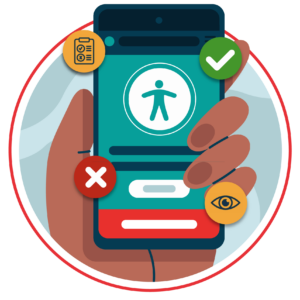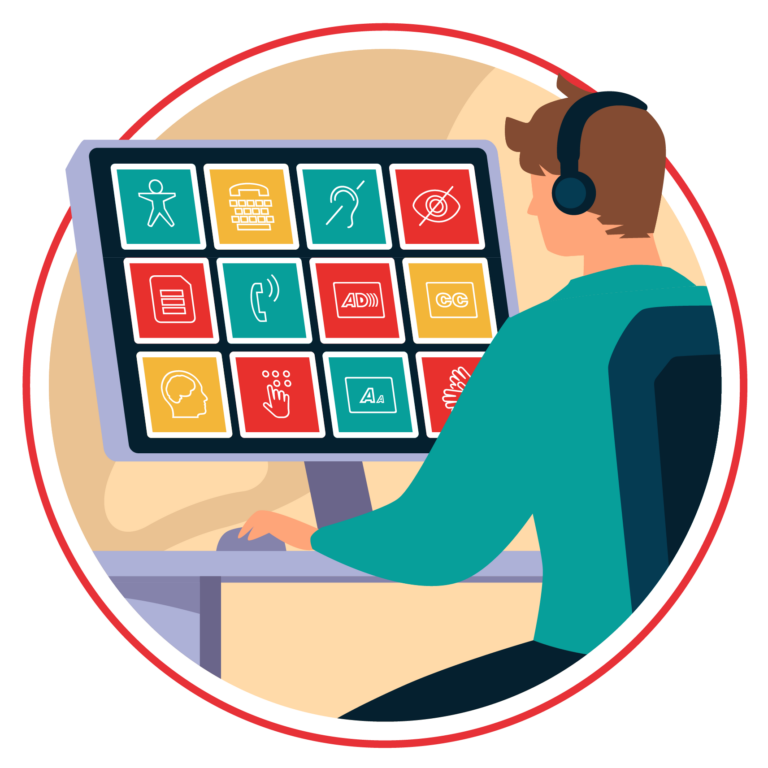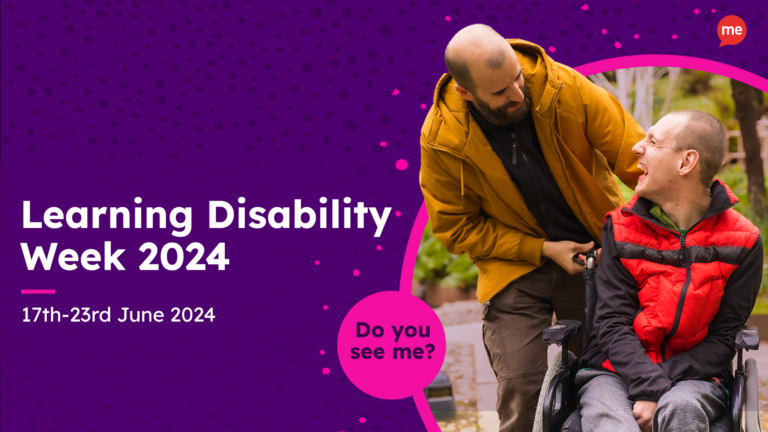Get Your Free Accessibility & Inclusion Toolkit
Download NowAutism is a condition that can affect anyone, there are around 75 million people globally who have been diagnosed with a form of autism. The condition can often make everyday activities and tasks more challenging for those who live with this disability. Assistive Technology is one of the important tools that can be implemented to help combat these challenges. This post will provide an overview of how assistive technology benefits people with autism and provide examples of assistive technologies for autism.
What are Assistive Technologies?
Assistive technologies (AT) are tools, devices, software, or equipment designed to enhance the functional capabilities and independence of individuals with disabilities. These technologies aim to mitigate the barriers and challenges that people with disabilities may encounter in their daily lives, enabling them to participate more fully in various activities, whether at home, in education, in the workplace, or in the community.
Assistive Technology is often divided into three categories, these are low-tech, mid-tech and high-tech. The definition for type is as follows:

What is Autism?
Autism, also known as Autism Spectrum Disorder (ASD), is a complex and lifelong neurodevelopmental condition that primarily affects social communication, behavior, and sensory processing. It is characterised by a wide spectrum of symptoms and challenges, which can vary greatly from one individual to another. Key features of autism may include difficulties in understanding and expressing emotions, challenges in forming and maintaining social relationships, repetitive behaviors or interests, and heightened or diminished sensitivity to sensory stimuli.
Autism is typically diagnosed in early childhood, and its severity can range from mild to severe. It is considered a spectrum disorder because individuals with autism can exhibit a diverse range of strengths and difficulties, leading to the concept of a “spectrum” of characteristics.
It’s important to note that while autism presents challenges in various aspects of life, many individuals with autism also possess unique talents, skills, and perspectives. Early intervention, individualised support, and therapies tailored to the individual’s specific needs can significantly enhance their quality of life and help them achieve their full potential. Autism is not a disease or something that can be “cured,” but rather a fundamental aspect of an individual’s neurodiversity.

Free Accessibility Check of your Website
Finding accessibility issues is now easier than ever. Recite Me offers a free automated scan of your website’s homepage to highlight non-compliance. You’ll get recommendations on how to fix them, helping to improve your accessibility score.
Low-Tech Assistive Technology
Low Tech Assistive Technology includes any devices or equipment that is simplistic in nature and requires minimal training to use. They are generally cheap to buy and less complex to operate. Specific examples of low-tech AT include:
- Magnifying Glasses
- Walking Canes
- Colour-coded organisers
- Visual Schedules
Mid-Tech Assistive Technology
Mid-tech Assistive Technology refers to a category of assistive devices and tools that fall between low-tech and high-tech solutions in terms of complexity and functionality. These assistive technologies are designed to support individuals with disabilities such as autism in various aspects of their daily lives, but they typically involve a moderate level of technology and may require some level of training or expertise to use effectively. Specific examples of mid-tech AT include:
- Wheelchair
- Audiobooks
- Visual timers
High-Tech Assistive Technology
High-tech Assistive Technology refers to advanced and sophisticated tools, devices, or systems that incorporate cutting-edge technology to assist individuals with disabilities in overcoming various challenges and enhancing their independence. High-tech assistive technologies leverage advanced electronics, software, and digital interfaces to provide more comprehensive and tailored solutions. Specific examples of high-tech AT include:
- Speech to text Technology
- Screen Readers
- Eye-gaze Communication Systems

Examples of Assistive Technology for Autism
There are dozens of great examples of assistive technologies that are important in the everyday lives of those with Autism. However, some of the most important and commonly used assistive technologies include:
Text-to-speech Software
A large proportion of autistic people find it difficult to read or comprehend written text. So, text-to-speech software can be leveraged to convert written text to spoken words. This makes the content easier to digest and understand if the individual has autism. Therefore, including assistive technology for reading on your website will enhance your brand’s accessibility and support people with a wide variety of disabilities, not just those with autism.
Text-to-speech Software can take shape in many different formats. For example, Audio Books and Screen Readers are two different manifestations of text-to-speech technology. Screen Reader accessibility is particularly important online, allowing autistic users to have website content and elements read aloud to them.
Audio Books provide access to written books by providing an audio format for those who struggle with reading. This is an example of how assistive technology works in the classroom, by creating an accessible environment, in which all students can take part.
Speech Recognition Software
Speech Recognition is another example of high-tech assistive technology in action. The software works by using an electronic device such as a mobile, computer or tablet to collect and convert spoken words to written text. Essentially this software provides the opposite function to text-to-speech.
This type of accessibility software provides important functionality for autistic people that experience difficulties with their writing skills. As there is a significant portion of the autistic population that experience difficulties with fine motor skills. So, allowing users to speak to the software and have it converted to written text can be extremely useful, as it removes the need to write or type text.
But, it doesn’t just benefit autistic people, this assistive technology benefits people with hearing impairments. As it allows for people’s spoken words to be converted to written text and digested that way by the end user.
Customisable Interfaces
Since we’ve already noted Autism is a spectrum of characteristics, the way it affects each person is unique. There are a range of different individual needs and requirements that differ between autistic people. Therefore, the ability to customise and adjust websites and their interfaces is very important.
Assistive tools such as the screen mask can be used to block out surrounding text and images on a web page. This is beneficial for those who find concentration difficult or have a heightened sensitivity to sensory stimuli. Additionally, font customisation can increase readability, this is traditionally an assistive technology for dyslexic people, but can also be beneficial for those with autism.
Task Management systems
People with autism can often have difficulties with understanding the concept of time and coping with daily tasks. Therefore, effective use of assistive technology devices that make use of task management can be leveraged to help assist with this process. This can help to schedule out daily tasks and provide a set time to complete tasks in, which can be easily followed. Further adjustments and customisations can be made based on the user’s preferences. For example, the use of colour-coded organisers can help the user differentiate between different task types.
Our 40-page Digital Accessibility & Inclusion Toolkit helps businesses break down online barriers and make a real impact. It offers practical advice on all aspects of digital accessibility, from writing an accessibility statement to accessible website tips and inclusive hiring.

Benefits of Assistive Technologies for Autistic People
Assistive Technology has an abundance of benefits that it affords people with autism. It addresses specific challenges faced on a daily basis in regards to communication, social interaction, sensory processing and improving quality of life on a day to day basis.
In reference to improved communication and social interactions, assistive technology provides this through speech-generating devices. This is essential for many nonverbal or minimally verbal individuals, allowing them to still communicate and express themselves in an effective way.
Furthermore, one of the most important benefits these technologies provide is confidence. People with any form of disability, including autism, can often feel disheartened and frustrated when they are unable to complete tasks that their disability impacts. By providing the necessary support to complete these otherwise inaccessible or frustrating tasks, it develops the individual’s confidence.
Additionally, the software can be used to help develop interpersonal skills and participate more effectively in educational settings. Helping autistic individuals to learn and better themselves, which again contributes to their overall confidence. But, it’s not just autism, assistive technology is great for ADHD and other similar conditions.
Start Your Web Accessibility Journey Today
The Recite Me team is here to help you build an inclusive and compliant website and save you time and money by highlighting what needs to be fixed first.
Get started today by contacting our team for more advice about making websites and business more inclusive online. You can also run a free website accessibility check with us today for free.







